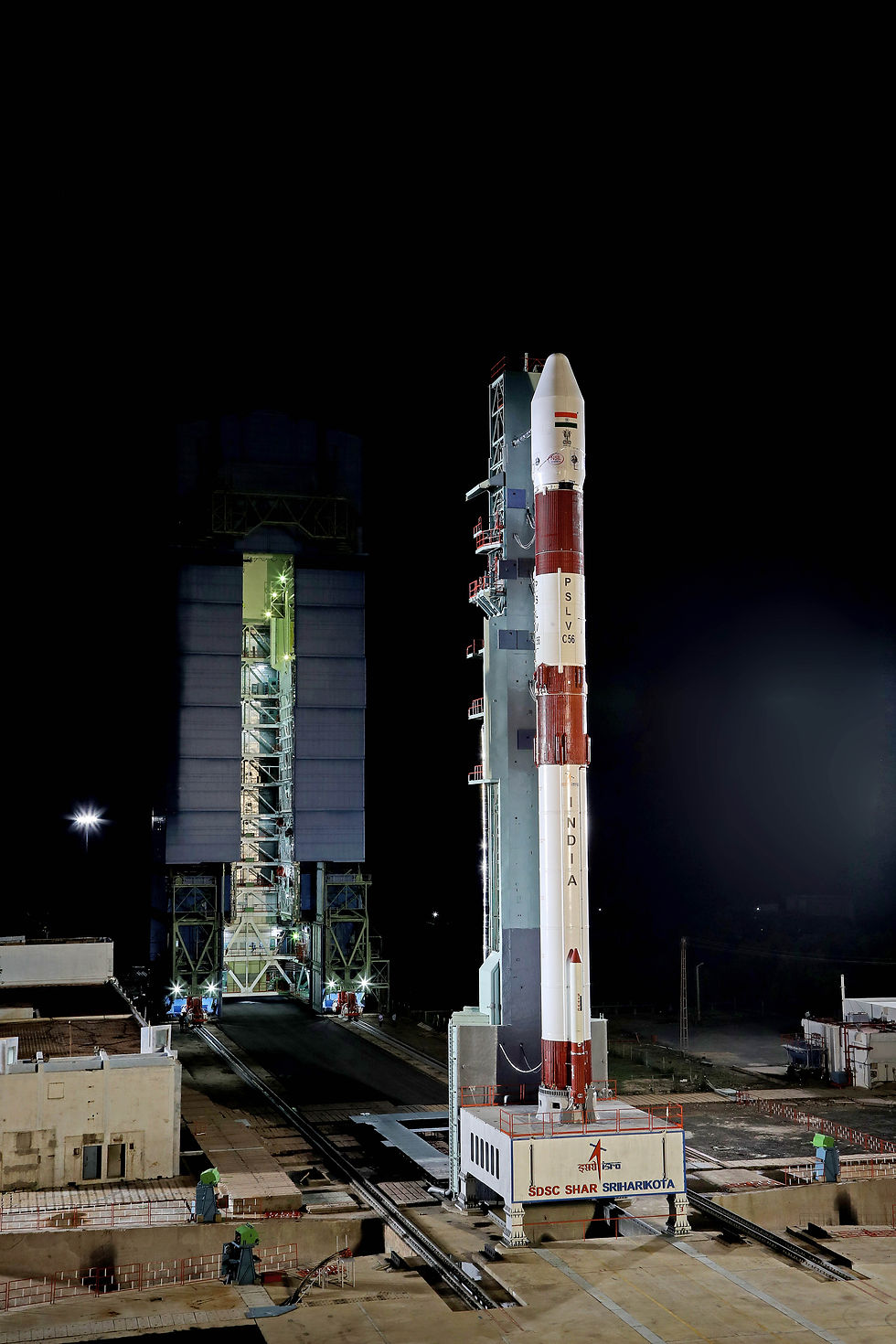ISRO's PSLV-C56 Mission Set to Launch DS-SAR and Six Microsatellites for Singapore
- Karthik Naren
- Jul 29, 2023
- 3 min read
PSLV-C56 is the Dedicated Commercial Mission of NewSpace India Limited
(NSIL) for ST Engineering

Chennai, July 29, 2023 - NewSpace India Limited (NSIL), the commercial arm of the Indian Space Research Organisation (ISRO), undertakes the launch of DS-SAR, a Radar Imaging Earth Observation satellite for ST Engineering, Singapore. This primary satellite will be accompanied by six microsatellites belonging to Singaporean customers.
The PSLV-C56 (Polar Satellite Launch Vehicle) mission utilizes the Core Alone configuration, signifying the 17th flight of India's workhorse launch vehicle. Liftoff is scheduled for 06:30 local time on July 30, 2023 (01:00 UTC) with the launch azimuth of 102º from the First Launch Pad (FLP) at Satish Dhawan Space Centre (SDSC) in Sriharikota,
The current launch follows the PSLV-C55/TeLEOS-2 mission, which was successfully launched in April to cater to customers in Singapore by ISRO.

The primary objective of this mission is to deploy DS-SAR into a 535 km Low Earth Orbit (LEO) with a 5-degree orbital inclination. DS-SAR's cutting-edge radar imaging technology promises to revolutionize Earth observation, enabling Singapore to make significant strides in disaster management, environmental monitoring, and maritime surveillance.
Space debris mitigation remains a top priority, and ISRO has incorporated measures to ensure responsible space practices. Following the main mission, the upper stage of the rocket will be carefully maneuvered to a lower orbit, ensuring its reduced orbital life and minimizing the risk of debris.
DS-SAR

DS-SAR is developed under a partnership between DSTA (representing the Government of Singapore) and ST Engineering. Once deployed and operational, it will be used to support the satellite imagery requirements of various agencies within the Government of Singapore.
ST Engineering will use it for multi-modal and higher responsiveness imagery and geospatial services for their commercial customers.
DS-SAR is a 352 kg satellite carries a Synthetic Aperture Radar (SAR) payload developed by Israel Aerospace Industries (IAI). This allows the DS-SAR provides for all-weather day and night coverage and is capable of imaging at 1m resolution at full polarimetry.

The acquisition of DS-SAR was announced at the Global Space & Technology Convention 2018 (GSTC), According to S. Iswaran, Singapore’s Minister for Trade and Industry, the satellite will be used for government and commercial purposes; DS-SAR will be used to support the satellite imagery requirements of Singapore government agencies, including for maritime security and the detection of oil spills. At the same time, the images captured by DS-SAR will be used to enhance ST Electronics’ commercial imagery services.“..we are continuing our investment in small satellites. I am pleased to share that the partnership between DSTA in Singapore and ST Electronics in Earth Observation satellite systems has taken another step forward this year. Together, they have acquired the next Earth Observation satellite called DS-SAR, which will carry a Synthetic Aperture Radar imaging payload - S. Iswaran.
Six Rideshare Payloads

VELOX-AM, a 23 kg technology demonstration microsatellite developed by Nanyang Technological University (NTU), Singapore, for the technology demonstration of Additive Manufacturing (AM) payloads.

ARCADE is a 27U microsatellite designed and built by Nanyang Technological University (NTU), Singapore, in collaboration with the INSPIRE (International Satellite Program in Research and Technology) consortium. ARCADE carries iodine-based solid propellant
propulsion module, based on the Hall effect thruster for orbit maintenance during the low-altitude mission.
Mass: 24 kg

SCOOB-II is a 3U CubeSat designed and developed by
a student team at Satellite Research Centre (SaRC),
Nanyang Technological University (NTU) in Singapore.
The satellite is designed for a 6-month mission lifetime.
SCOOB-II utilizes a three-axis controlled reaction
wheel assembly for attitude control.
Mass: 4 kg

NuLIoN is a 3U nanosatellite developed by NuSpace as the seed satellite for a LEO equatorial constellation providing continuous LoRaWAN IoT services.
NuLIoN is Nuspace's first commercial satellite aimed at bridging the connectivity gap. NuSpace provides reliable regional coverage and data collection services to allow anyone in Southeast Asia to use the satellite to monitor and observe data points that really matter to them. Additionally, it also serves as a payload testing bed in space, with different companies partnering with NuSpace to test their devices!
Mass: 3 kg

Galassia-2 is an educational 3U nanosatellite by National University of Singapore (NUS). The main mission of GALASSIA-2 is to perform an inter-satellite link (ISL) with TeLEOS-1. Galassia-2 will demonstrate the capability of using "Commercial Off The Shelf" (COTS) multispectral imagery for space applications.
Mass: 3.5 kg
ORB-12 STRIDER is developed under an international collaboration, coordinated by Singapore-based ALIENA, including Orbital Astronautics as bus providers, and Aurora Propulsion Technologies as subsystem co-developers.

It will demonstrate next-generation propulsion systems catered specifically for small satellite constellations. ORB-12 STRIDER will carry the world’s first Multi-modal all-Electric Propulsion Engine (MEPE), featuring ALIENA’s flagship Multi-Stage Ignition Compact (MUSIC) Hall thruster and Aurora’s ARM resistojets.
The ORB-12 Strider mission will serve as an extensive testing and demonstration platform for various in-house developed systems. Among them, an optical transceiver with a two-axis precision-steering mechanism for inter-satellite communications will be included as part of OrbAstro's Guardian Network constellation, which facilitates data relay and autonomous satellite operations.
Mass: 13 kg

Live Stream:

Comments